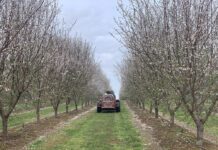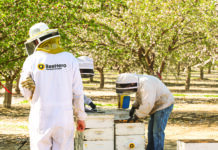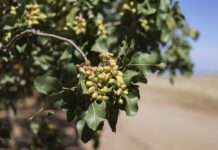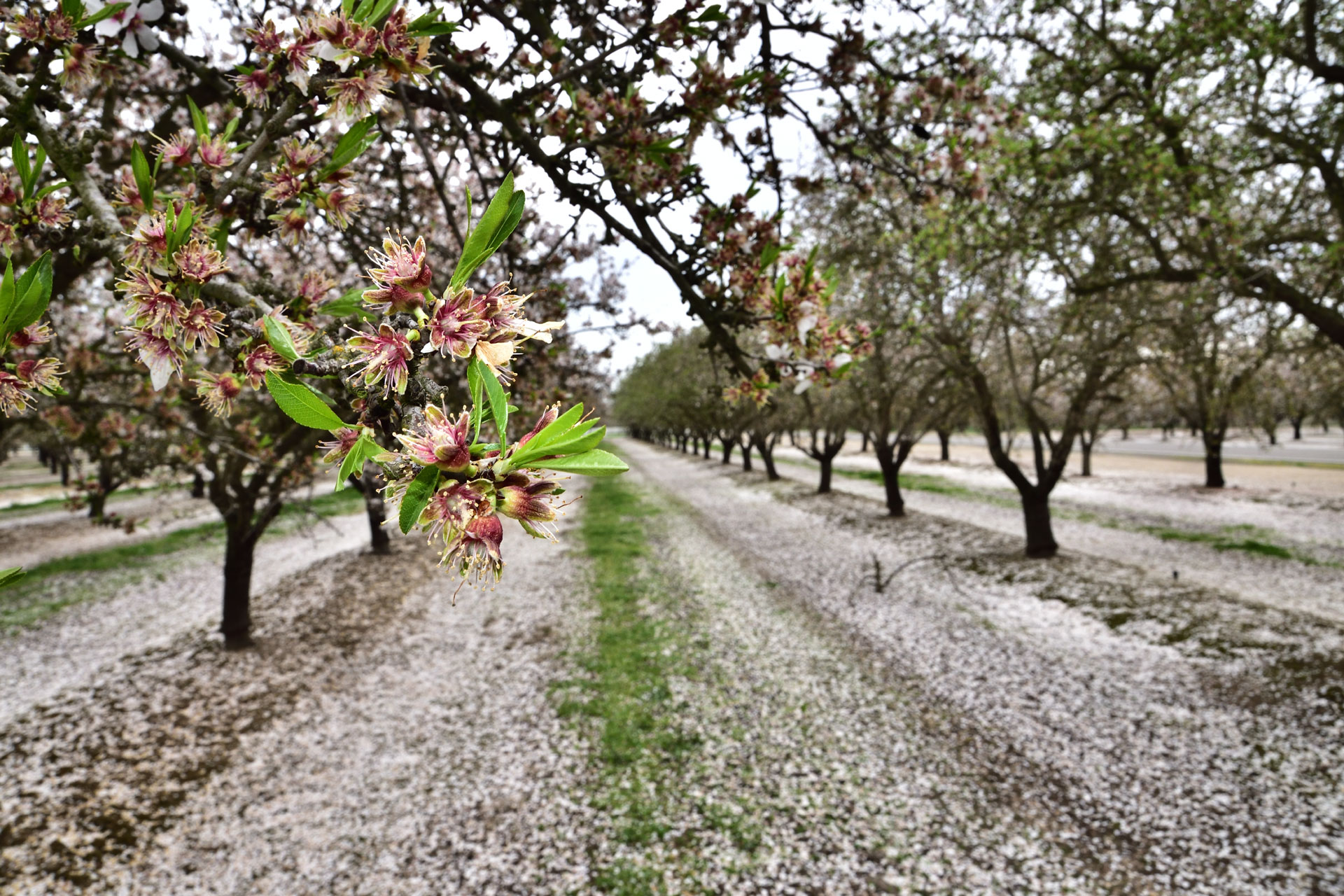
Trees don’t go out and buy pumpkin spice lattes when temperatures drop, but nut trees have another way of responding to cooler fall temperatures. Trees signal the visual start of their winter dormant period, dormancy, by dropping leaves as temperatures and sunlight hours decrease. During dormancy, growth is suspended even if growing conditions are ideal.
Dormancy ends when growth resumes in the spring, but what happens during the ‘dormant season’ can have an effect on tree productivity.
Although leafless during dormancy, deciduous trees are still functioning internally, sustained by carbohydrate reserves. Without leaves and green shoots, they are less vulnerable to damage during severe freeze events over the winter. Warmer temperatures in the spring are a signal to the trees to come out of dormancy. They use carbohydrate reserves to bloom and set a new crop.
Winter Chill
Walnut trees, pistachio trees and, to some extent, almond trees, need to experience cold temperatures during their winter dormant period, from leaf fall until growth resumes in the spring.
UCCE Orchard Systems Advisor Katherine Jarvis-Shean said if orchards experience the right amount of winter chill and subsequent warmer temperatures in the spring, they come out of dormancy synchronized and prepared to bloom and set a crop. There are three ways this can go wrong in mature walnut and pistachio orchards during dormancy, she said, noting almond trees have less winter chill requirements during dormancy than walnut and pistachio trees.
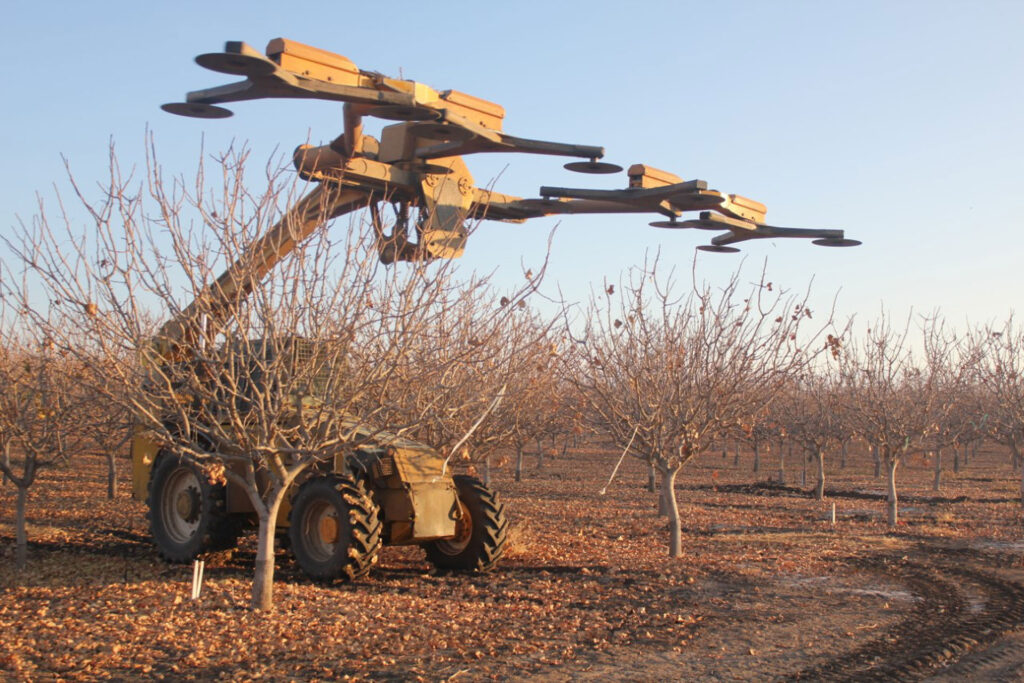
Pistachio trees that do not experience sufficient chill during dormancy will have asynchronized bloom; the female trees will have flowers open, but male trees have yet to produce pollen. This difference in timing, Jarvis-Shean said, is one reason that the new pollinizer Randy is favored over Peters, which has more need for chill. Walnut trees overcome this lack of overlap with more varieties that produce pollen at varying times.
The second result of warm temperatures during dormancy is a longer duration of bud break. A larger window from the first to last bud break becomes problematic as harvest nears. This uneven maturity of the crop will mean that multiple shakes at harvest may be required. After two shakes, Jarvis-Shean said, it can become uneconomical to bring in equipment for a third shake and 10% to 15% of the crop may be left in the orchard. Finally, looking back on the infamous low chill year of 2014-15, lower yields in pistachio were the result as female trees produced far fewer flowers to be pollinated.
In a research paper, UC Davis Plant Scientist Maciej Zwieniecki reports that temperature variability during the dormant period affects bloom. It is a common perception that warmer winters shorten the dormancy period and advance bloom, but they can also delay bloom and make it asynchronous or cause trees to leaf out early, which can affect yields at harvest. Winter temperatures, he noted, can either induce biological processes critical to endodormancy or activate bloom.
Zwieniecki said that a tree’s nonstructural carbohydrate reserves at senescence are vital to sustaining their metabolism throughout dormancy. Trees need sufficient energy at the end of the dormant period for bud break and bloom.
Non-Structural Carbohydrates
Research being done at the UC Davis “Z Lab” is looking at what is happening in orchards during the dormant period, how trees prepare for winter and how they emerge from dormancy in the spring. This research, writes Jarvis-Shean in Sac Valley Orchard Source, will help explain how trees may be counting winter chill and spring heat, and the information developed can be used to create bloom prediction tools.
One of the avenues of study is in non-structural carbohydrates (NSC), which are used by trees for energy and as signals for multiple physiological activities. Following the amount of NSC in a plant over time helps to understand how the trees are using carbohydrates.
Jarvis-Shean explained that NSC are either sugars or starch. Starch is the storage form of carbohydrates. Starch can be broken down to provide sugars. When temperatures warm, trees turn sugars into starch and in colder temperatures, trees turn starch into sugars. To keep sugars in the optimum range, trees adjust the concentration of enzymes that break down starches using gene expression machinery. Trees’ effort in maintaining a balance likely plays a role in how trees count winter chill and emerge from dormancy.
There are still many questions about tree physiology, carbohydrate use and effects of winter temperatures on carbohydrate storage.
Zwieniecki’s ongoing research is looking at the interactions between winter temperatures, trees’ carbohydrate levels and production. He is looking for the most important elements of the interactions in order to guide management decisions.
Nut trees evolved by storing NSC in the fall to use to survive winter. As temperatures warm in the spring, the carbohydrates move to locations near buds, and the trees use this energy to produce flowers. This complicated system is part of how trees adapt to climate, Zwieniecki said.
Questions Zwieniecki is addressing in his research are if it is a good idea to fully load the trees with carbohydrates in the fall, if they will be wasted, and if high levels will drive high production.
“There are different trade offs in these situations,” he said.
His Carbohydrate Observatory research has found that, in the case of almond, the amount of carbohydrates a tree has in February is a good indicator of yields at harvest. What happens during other periods, including winter, also influences carbohydrate levels. Higher temperatures than normal increase respiration and use of NSC by trees. Winter temperature swings, he found, can cause the tree to redistribute carbohydrates, pulling them from twigs to roots. At that location, he said they are still stored, but not available for trees to push flowers at the end of dormancy.
“Once we resolve the biology of the tree’s use of carbohydrates, then we will know how to guide management,” Zwieniecki said.







